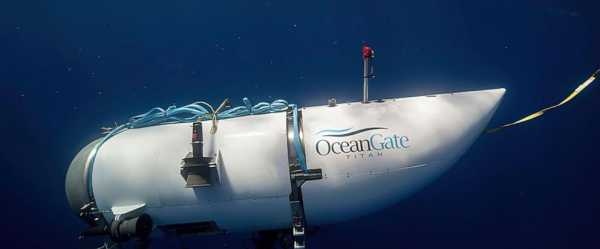
The search for a missing Titanic-bound submersible has become an investigation and salvage mission that will take an indefinite amount of time, officials said, as tributes from around the world poured in for the five people killed when the vessel imploded deep in the North Atlantic.
The announcement Thursday that all aboard perished when the submersible imploded near the site of the iconic shipwreck brought a tragic end to a five-day saga that included an urgent around-the-clock search and a worldwide vigil for the vessel known as the Titan.
The investigation into what happened was already underway and would continue in the area around Titanic where debris from the submersible was found, said Rear Adm. John Mauger, of the First Coast Guard District.
“I know there are also a lot of questions about how, why and when did this happen. Those are questions we will collect as much information as we can about now,” Mauger said, adding that it was a “complex case” that happened in a remote part of the ocean and involved people from several different countries.
The first hint of a timeline came Thursday evening when a senior U.S. Navy official said that after the Titan was reported missing Sunday, the Navy went back and analyzed its acoustic data and found an “anomaly” that was consistent with an implosion or explosion in the general vicinity of where the vessel was operating when communications were lost. The official spoke on condition of anonymity to discuss a sensitive acoustic detection system.
Those killed were Stockton Rush, the CEO of OceanGate Expeditions, the company that owned and operated the submersible; two members of a prominent Pakistani family, Shahzada Dawood and his son Suleman Dawood; British adventurer Hamish Harding; and Titanic expert Paul-Henri Nargeolet.
OceanGate, which has been chronicling the Titanic’s decay and the underwater ecosystem around it via yearly voyages since 2021 that included paying tourists, released a statement calling all five people killed "true explorers who shared a distinct spirit of adventure, and a deep passion for exploring and protecting the world’s oceans.”
Tributes to those killed and praise for the searchers who tried to save them poured in from across the globe. The White House thanked the Coast Guard, along with Canadian, British and French partners who helped in the search and rescue efforts.
“Our hearts go out to the families and loved ones of those who lost their lives on the Titan. They have been through a harrowing ordeal over the past few days, and we are keeping them in our thoughts and prayers,” it said in a statement.
Pakistan’s Foreign Ministry wrote on Twitter that it appreciates "the multinational efforts over the last several days in search of the vessel.” The Dawood family also thanked all involved in the search.
“Their untiring efforts were a source of strength for us during this time,” the family said in a statement. “We are also indebted to our friends, family, colleagues and well-wishers from all over the world who stood by us during our need.”
The Titan launched at 6 a.m. Sunday and was reported overdue Sunday afternoon about 435 miles (700 kilometers) south of St. John’s, Newfoundland. Rescuers rushed ships, planes and other equipment to the site of the disappearance.
Authorities were hoping underwater sounds detected Tuesday and Wednesday might help narrow their search, whose coverage area had been expanded to thousands of miles — twice the size of Connecticut and in waters 2 1/2 miles (4 kilometers) deep.
Any sliver of hope that remained for finding the crew alive, however, was wiped away early Thursday, when the submersible’s 96-hour supply of air was expected to run out and the Coast Guard announced that a debris field had been found roughly 1,600 feet (488 meters) from the Titanic.
“The debris is consistent with the catastrophic loss of the pressure chamber,” Mauger said.
The Coast Guard said Thursday that the sounds heard in the previous days were likely generated by something other than the Titan.
“There doesn’t appear to be any connection between the noises and the location (of the debris) on the seafloor,” Mauger said.
The Navy official who spoke of the “anomaly” heard Sunday said the Navy passed on the information to the Coast Guard, which continued its search because the Navy did not consider the data to be definitive.
At least 46 people successfully traveled on OceanGate’s submersible to the Titanic wreck site in 2021 and 2022, according to letters the company filed with a U.S. District Court in Norfolk, Virginia, that oversees matters involving the Titanic shipwreck. But questions about the submersible's safety were raised by both by a former company employee and former passengers.
David Lochridge, OceanGate’s former director of marine operations, argued in 2018 that the method the company devised for ensuring the soundness of the hull — relying on acoustic monitoring that could detect cracks and pops as the hull strained under pressure — was inadequate and could “subject passengers to potential extreme danger in an experimental submersible.”
“This was problematic because this type of acoustic analysis would only show when a component is about to fail — often milliseconds before an implosion — and would not detect any existing flaws prior to putting pressure onto the hull,” Lochridge’s attorneys wrote in a wrongful termination claim.
OceanGate disagreed. Lochridge “is not an engineer and was not hired or asked to perform engineering services on the Titan,” it said, and it noted he was fired after refusing to accept assurances from the company's lead engineer that the acoustic monitoring and testing protocol was, in fact, better suited to detect any flaws than a method Lochridge proposed.
One of the company’s first customers likened a dive he made to the site two years ago to a suicide mission.
“Imagine a metal tube a few meters long with a sheet of metal for a floor. You can’t stand. You can’t kneel. Everyone is sitting close to or on top of each other,” said Arthur Loibl, a retired businessman and adventurer from Germany. “You can’t be claustrophobic.”
During the 2 1/2-hour descent and ascent, the lights were turned off to conserve energy, he said, with the only illumination coming from a fluorescent glow stick.
The dive was repeatedly delayed to fix a problem with the battery and the balancing weights. In total, the voyage took 10 1/2 hours.
Nicolai Roterman, a deep-sea ecologist and lecturer in marine biology at the University of Portsmouth, England, said the disappearance of the Titan highlights the dangers and unknowns of deep-sea tourism.
“Even the most reliable technology can fail, and therefore accidents will happen. With the growth in deep-sea tourism, we must expect more incidents like this.”
___
Associated Press writers Jon Gambrell in Dubai, United Arab Emirates; Ben Finley in Norfolk, Virginia; Holly Ramer in Concord, New Hampshire; Lolita C. Baldor in Washington; Frank Jordans in Berlin; Danica Kirka in London; Gene Johnson in Seattle; Munir Ahmed in Islamabad; and John Leicester in Paris contributed to this report.
Sourse: abcnews.go.com






